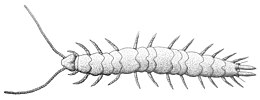Symphyla
| Symphyla | |
|---|---|
 |
|
| Scutigerella immaculata | |
 |
|
| Unidentified species | |
| Scientific classification | |
| Kingdom: | Animalia |
| Phylum: | Arthropoda |
| Subphylum: | Myriapoda |
| Class: |
Symphyla Ryder, 1880 |
| Families | |
Scutigerellidae
Scolopendrellidae
Symphylans, also known as garden centipedes or pseudocentipedes, are soil-dwelling arthropods of the class Symphyla in the subphylum Myriapoda. Symphylans resemble centipedes, but are smaller and translucent, and only distantly related to true centipedes. They can move rapidly through the pores between soil particles, and are typically found from the surface down to a depth of about 50 cm. They consume decaying vegetation, but can do considerable harm in an agricultural setting by consuming seeds, roots, and root hairs in cultivated soil.
Juveniles have six pairs of legs, but, over a lifetime of several years, add an additional pair at each moult so that the adult instar has twelve pairs of legs. Lacking eyes, their long antennae serve as sense organs. They have several features linking them to early insects, such as a labium (fused second maxillae), an identical number of head segments and certain features of their legs.
About 200 species are known worldwide.
Symphyla are small, cryptic myriapods without eyes and without pigment. The body is soft and generally 2 to 10 millimetres (0.08 to 0.4 in) long, divided into two body regions: head and trunk. An exceptional size is reached in Hanseniella magna, which attains lengths of 25 to 30 mm (1.0 to 1.2 in).
The head has long, segmented antennae, a postantennal organ, three pairs of mouthparts: mandibles, the long first maxillae, and the second pair of maxillae which are fused to form the lower lip or labium of the mouth. Disc-like organs of Tömösváry, which probably sense vibrations, are attached to the base of the antennae, as they are in centipedes.
The trunk comprises 15–24 segments, which are protected by overlapping dorsal plates. Ten or twelve segments bear legs. The first segment is large and usually provided with a pair of legs, the last segment is slender, lacks legs, and possesses a pair of cerci. Immature individuals have six pairs of legs on hatching. Each pair of legs is associated with an eversible structure, called a "coxal sac", that helps the animal absorb moisture, and a small stylus that may be sensory in function. Similar structures are found in the most primitive insects.
...
Wikipedia
